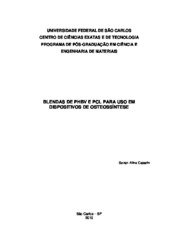| dc.contributor.author | Casarin, Suzan Aline | |
| dc.date.accessioned | 2016-06-02T19:10:05Z | |
| dc.date.available | 2011-03-29 | |
| dc.date.available | 2016-06-02T19:10:05Z | |
| dc.date.issued | 2010-12-15 | |
| dc.identifier.citation | CASARIN, Suzan Aline. Blends of PHBV and PCL for use in osteosynthesis devices. 2010. 187 f. Tese (Doutorado em Ciências Exatas e da Terra) - Universidade Federal de São Carlos, São Carlos, 2010. | por |
| dc.identifier.uri | https://repositorio.ufscar.br/handle/ufscar/678 | |
| dc.description.abstract | This study aimed to develop and characterize polymer blends using biodegradable and bioabsorbable polymers poly (hydroxybutyrate-co-valerate) PHBV with 12% valerate, and poly (ε-caprolactone) PCL, in order to make the PHBV less fragile for applications such as osteosynthesis devices. We studied the binary mixture of these polymers in the compositions PHBV / PCL (75/25 and 50/50). The polymer blends were prepared in order to simulate a large-scale industrial process, by extrusion followed by injection. The pure polymers and polymer blends were evaluated and characterized by: Melt Flow Index (MFI), Thermal Analysis (TG, DSC and DMTA), Optical Microscopy, Scanning Electron Microscopy (SEM), Thermal Test of the Heat Deflection Temperature (HDT), Mechanical Tests (impact, tensile and flexural), Size Exclusion Chromatography (SEC), analysis of in vitro degradation and Cytotoxicity Analysis, direct and indirect. The results obtained through different techniques indicated the immiscibility of PHBV / PCL blends. In terms of mechanical properties, the polymer blends analyzed indicated better characteristics than copolymer PHBV, presenting a less brittle behavior. In the in vitro study, in phosphate buffered saline solution with pH 7.3, the PHBV and PCL samples indicated a slow degradation behavior when compared to other bioabsorbable polymers. Along the degradation period, the polymers became more rigid, increasing the values of the Tensile Modulus of Elasticity. It was verified that, depending on the degradation period, there was a reduction in the values of molar masses of the samples studied. Through the cytotoxicity analysis, it was found that the pure polymers and the blends studied did not indicate indirect toxicity. However, the results indicated toxicity through the direct contact with the polymers studied, which may be related to the superficial characteristics thereof. | eng |
| dc.format | application/pdf | por |
| dc.language | por | por |
| dc.publisher | Universidade Federal de São Carlos | por |
| dc.rights | Acesso Aberto | por |
| dc.subject | Polímeros | por |
| dc.subject | Polímeros biodegradáveis | por |
| dc.subject | Blendas poliméricas | por |
| dc.subject | Poli (Hidroxibutirato-co-hidroxivalerato) - PHBV | por |
| dc.subject | Polímeros biorreabsorvíveis | por |
| dc.title | Blendas de PHBV e PCL para uso em dispositivos de osteossíntese | por |
| dc.title.alternative | Blends of PHBV and PCL for use in osteosynthesis devices | eng |
| dc.type | Tese | por |
| dc.contributor.advisor1 | Agnelli, José Augusto Marcondes | |
| dc.contributor.advisor1Lattes | http://genos.cnpq.br:12010/dwlattes/owa/prc_imp_cv_int?f_cod=K4727641E3 | por |
| dc.description.resumo | O objetivo deste trabalho foi desenvolver e caracterizar blendas poliméricas utilizando os polímeros biodegradáveis e biorreabsorvíveis poli(hidroxibutirato-co-valerato) PHBV, com 12% de valerato, e poli(ε- caprolactona) - PCL, com a finalidade de tornar o PHBV menos frágil para aplicações tais como dispositivos de osteossíntese. Estudou-se a mistura binária desses polímeros nas composições PHBV/PCL (75/25 e 50/50). As blendas poliméricas foram preparadas de maneira a simular um processo industrial em grande escala, por extrusão seguida de injeção. Os polímeros puros e as blendas poliméricas foram avaliados e caracterizados por: Índice de fluidez (MFI), Análises Térmicas (TG, DSC e DMTA), Microscopia óptica, Microscopia eletrônica de varredura (MEV), Ensaio térmico de temperatura de deflexão ao calor sob carga (HDT), Ensaios mecânicos (impacto, tração e flexão), Cromatografia de exclusão por tamanho (SEC), Análise de degradação in vitro e Análise de Citotoxicidade, indireta e direta. Os resultados obtidos através de diversas técnicas indicaram a imiscibilidade das blendas PHBV/PCL. Em termos das propriedades mecânicas, as blendas poliméricas estudadas apresentaram características melhores que o copolímero PHBV, apresentando comportamento menos frágil. No estudo in vitro, em solução tampão de fosfato salino com pH 7.3, as amostras de PHBV e de PCL mostraram um comportamento de degradação lenta quando comparados a outros polímeros biorreabsorvíveis. Em função do tempo de degradação os polímeros tornaram-se mais rígidos, aumentando assim os valores dos módulos de elasticidade em tração. Comprovou-se que, em função do tempo de degradação, houve uma redução nos valores das massas molares das amostras estudadas. Através da análise de citotoxicidade constatou-se que os polímeros puros e as blendas estudados não apresentaram toxicidade indireta. Porém, os resultados mostraram toxicidade por contato direto com os polímeros estudados, o que pode estar relacionado às características superficiais dos mesmos. | por |
| dc.publisher.country | BR | por |
| dc.publisher.initials | UFSCar | por |
| dc.publisher.program | Programa de Pós-Graduação em Ciência e Engenharia de Materiais - PPGCEM | por |
| dc.subject.cnpq | ENGENHARIAS::ENGENHARIA DE MATERIAIS E METALURGICA | por |
| dc.contributor.authorlattes | http://lattes.cnpq.br/9959295737759646 | por |
